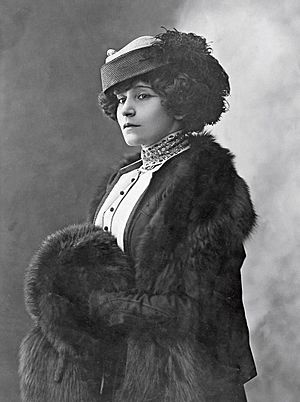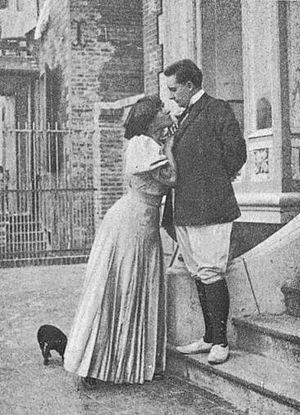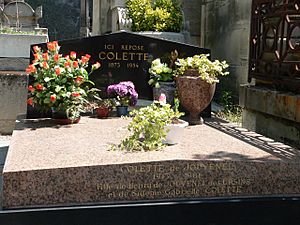Colette facts for kids
Quick facts for kids
Colette
|
|
|---|---|

Colette, possibly in the 1910s
|
|
| Born | Sidonie-Gabrielle Colette 28 January 1873 Saint-Sauveur-en-Puisaye, Burgundy, France |
| Died | 3 August 1954 (aged 81) Paris, France |
| Resting place | Père Lachaise Cemetery |
| Pen name |
|
| Occupation | Novelist |
| Notable works |
|
| Signature | |
 |
|
Sidonie-Gabrielle Colette (born January 28, 1873 – died August 3, 1954), known simply as Colette, was a famous French writer. She was also a mime artist, actress, and journalist. Many people know Colette for her 1944 story Gigi. This story later became a popular movie in 1958 and a stage musical in 1973. Her collection of short stories called The Tendrils of the Vine is also very well-known in France.
Contents
Life and Writing Career
Colette's Family and Early Life
Sidonie-Gabrielle Colette was born on January 28, 1873. Her birthplace was a small village called Saint-Sauveur-en-Puisaye in Burgundy, France. Her father, Jules-Joseph Colette, was a war hero and tax collector. Her mother was Adèle Eugénie Sidonie, often called "Sido."
Colette had three older siblings. She went to a public school from age 6 to 17. Her family was quite comfortable at first. However, they faced money problems later on.
Becoming a Writer with "Willy"
In 1893, Colette married Henry Gauthier-Villars. He was a well-known author and publisher who used the pen name "Willy." Colette's first four novels were the "Claudine" stories. These included Claudine à l'école (1900) and Claudine à Paris (1901). They were published under Willy's name.
These novels tell the story of a young girl named Claudine growing up. She goes from an unusual teenager in a village to a well-known figure in Paris. The stories were partly based on Colette's own life. Colette later said she might not have become a writer without Willy. Willy encouraged her writing, sometimes even making her stay in her room until she wrote enough pages.
Colette and Willy separated in 1906 and divorced in 1910. Colette did not get money from the "Claudine" books because Willy owned the copyright. So, she started a stage career in music halls across France. She sometimes played Claudine in shows based on her own novels. She earned just enough to get by. To make more money, she also started working as a journalist.
During these years, she explored relationships with other women. One notable relationship was with Mathilde de Morny, also known as "Max." In 1907, a kiss between Max and Colette on stage caused a stir. This event meant they could no longer live together openly. Colette wrote about this time in her novel La Vagabonde (1910). This book explored themes of women's independence.
In 1912, Colette married Henry de Jouvenel, who was an editor for a newspaper called Le Matin. They had a daughter named Colette de Jouvenel in 1913.
Productive Years of Writing
In 1920, Colette published Chéri. This novel explored a relationship between an older woman and a much younger man. Colette's marriage to Jouvenel ended in divorce in 1924.
In 1925, she met Maurice Goudeket, who became her last husband. They stayed together until she passed away. By this time, Colette was a well-known writer. The 1920s and 1930s were her most creative and busy years. Her stories often took place in Burgundy or Paris. They often focused on married life and were partly based on her own experiences.
Many people praised Colette as France's greatest woman writer. Critics admired her genius and beautiful writing style.
Later Years and Famous Works
Colette was 67 years old when France was occupied by the Germans during World War II. She stayed in her apartment in Paris. Her husband, Maurice Goudeket, who was Jewish, was arrested in 1941. He was released after seven weeks, but Colette worried about him for the rest of the war. During this time, she wrote two books of memoirs. She also wrote articles for some newspapers.
In 1944, Colette published her most famous work, Gigi. This story is about a 16-year-old girl named Gilberte, or "Gigi."
- In 1949, a French film was made based on Gigi.
- In 1951, it was turned into a stage play. The then-unknown Audrey Hepburn played Gigi, chosen by Colette herself.
- The 1958 Hollywood musical movie, starring Leslie Caron, won the Academy Award for Best Picture.
After the war, Colette became a very famous public figure. She had severe arthritis and was cared for by Goudeket. She continued to write, publishing L'Etoile Vesper (1946) and Le Fanal Bleu (1949). In these books, she thought about the challenges of a writer who mostly writes about their own life. She was nominated for the Nobel Prize in Literature in 1948.
Colette the Journalist
Colette's first journalism pieces were written with her first husband, Willy. After their divorce, she wrote on her own for many different publications. She became well-known for her articles about social trends, theater, fashion, film, and even crime.
In 1910, Colette started writing a regular column for the Paris newspaper Le Matin. One of her editors was Henry de Jouvenel, whom she later married. By 1912, Colette had become a skilled reporter. In 1914, she was named Le Matin's literary editor.
After separating from Jouvenel in 1923, she wrote for many other magazines and newspapers. These included Vogue and Le Figaro. During the German Occupation of France, Colette continued to write for daily and weekly publications. Some of these publications supported the wartime government. Her articles were not political, but some people criticized her for writing for these papers. Over her career, Colette published more than 1200 articles.
Death and Legacy
Colette passed away on August 3, 1954. She was not given a religious funeral because she had been divorced. However, she was given a special state funeral, which was a great honor for a French woman writer. She was buried in Père Lachaise Cemetery in Paris.
Colette received many honors during her life. She was elected to the Belgian Royal Academy in 1935. She also became a member of the Académie Goncourt in 1945 and its President in 1949. She was also awarded the Légion d'honneur, a very high French award.
Many people have studied Colette's life and work. At first, some thought she was a good but limited writer. However, over time, she has been recognized as a very important voice in women's writing. Before Colette died, writer Katherine Anne Porter called her "the greatest living French writer of fiction."
Colette's work has inspired many artists.
- Singer-songwriter Rosanne Cash wrote a song called "The Summer I Read Colette."
- Writer Truman Capote wrote an essay about meeting her called "The White Rose."
- A song by Julia Holter called "Lucette Stranded on the Island" is based on a character from one of Colette's short stories.
Several films have been made about Colette's life:
- The 1991 film Becoming Colette starred Mathilda May.
- The 2018 film Colette starred Keira Knightley. Both films focused on her early life and how her first novels were published under her husband's name.
Notable Works
- Claudine à l'école (1900, translated as Claudine at School)
- Claudine à Paris (1901, translated as Claudine in Paris)
- Claudine en ménage (1902, translated as Claudine Married)
- Claudine s'en va (1903, translated as Claudine and Annie)
- Les Vrilles de la vigne (1908)
- La Vagabonde (1910)
- Mitsou (1919)
- Chéri (1920)
- La Maison de Claudine (1922, translated as The House of Claudine)
- Le Blé en herbe (1923, translated as Ripening Seed)
- La Fin de Chéri (1926, translated as The Last of Chéri or The End of Chéri)
- La Naissance du jour (1928, translated as Break of Day)
- Sido (1929)
- La Chatte (1933)
- Gigi (1944)
- Le Fanal Bleu (1949, translated as The Blue Lantern)
Films Based on Colette's Works
- Gigi, directed by Jacqueline Audry (France, 1949, based on Gigi)
- Le Blé en herbe, directed by Claude Autant-Lara (France, 1954, based on Green Wheat)
- Gigi, directed by Vincente Minnelli (1958, based on Gigi)
- Chéri, directed by Stephen Frears (UK, 2009, based on Chéri)
Films About Colette
- Becoming Colette, directed by Danny Huston (1991), with Mathilda May as Colette
- Colette, directed by Wash Westmoreland (2018), with Keira Knightley as Colette
See also
 In Spanish: Colette para niños
In Spanish: Colette para niños
- Le Monde's 100 Books of the Century, a list which includes Les Vrilles de la vigne
- Mononymous persons




